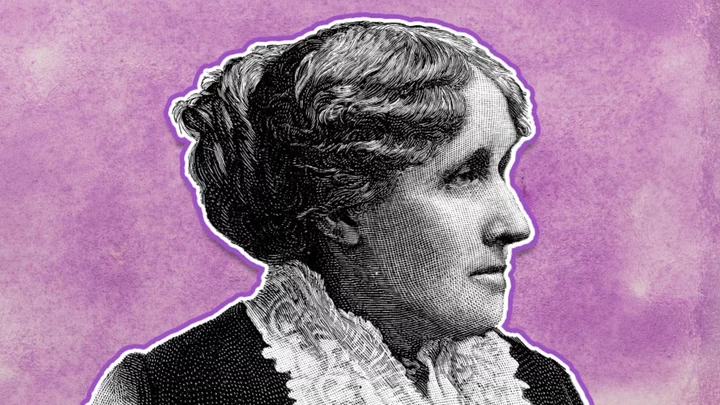In 1898, Henry James published The Turn of the Screw, a bone-chilling novella about a governess, two seemingly saintly children, and a couple of wicked ghosts who may or may not actually be there. James wanted his terrifying tale to “scare the whole world,” and more than a century later, it’s still doing just that. The story has inspired countless adaptations in every format, the most recent being Netflix’s The Haunting of Bly Manor—a follow-up to 2018’s The Haunting of Hill House (which was based on Shirley Jackson’s classic 1959 novel). Prepare to be unnerved all over again with these facts about the classic novella.
1. The Archbishop of Canterbury planted the seed that inspired The Turn of the Screw.
One afternoon in January 1895, Henry James and his cohorts were gathered around the fire at the country house of Edward White Benson, the Archbishop of Canterbury. While discussing how ghost stories had diminished in both quality and quantity, the esteemed church leader recounted a worthy one that a woman had told him years before. The story, James later wrote in his journal, involved “wicked and depraved” servants who “corrupt and deprave the children” in their charge and come back to haunt them after dying under mysterious circumstances. James also jotted down that the story should be told “by an outside spectator.” Not only does the story itself follow the basic plot of The Turn of the Screw, but James’s own fireside experience mirrors the opening frame of his novella, in which a man tells a ghost story that he first heard from a woman.
Benson died a couple of years before James got around to writing the story, and Benson’s sons couldn’t recall their father ever having shared an anecdote that echoed it. But it seems probable that James spun his own story based on just a sentence or two; in his preface to the novella, he wrote that their host only remembered a “shadow of a shadow” of the story, likening it to a “precious pinch … extracted from an old silver snuff-box and held between finger and thumb.”
2. Henry James’s main reason for writing The Turn of the Screw was because he needed money.
The royalties for James’s early novels were beginning to dry up by the 1890s, which prompted him to briefly pivot to playwriting. While most of his plays remained on paper only, Guy Domville did open in London in 1895—and it was a disaster. “I’m the last, my lord, of the Domvilles!” the titular character exclaimed at the end, to which one disgruntled theatergoer allegedly very audibly responded, “It’s a bloody good thing y’are!”
James, humiliated and short on cash, quit theater and soon moved to New York. There, he resigned himself to work he despised: Writing serials for magazines. One of these was The Turn of the Screw, published in Collier’s Weekly between January and April 1898. “I have succumbed, in that matter, purely to the pecuniary argument … It means £40 a month, which I simply couldn’t afford not to accept,” James told fellow novelist William Dean Howells in a letter, confessing that he “will do it again & again, too, even for the same scant fee: it’s only a question of a chance!”
3. James didn’t originally think much of The Turn of the Screw ...
James seemed to have a tough time separating his serialized work from the begrudging financial motivation behind it. He referred to it sardonically as “Literature drivel,” and considered The Turn of the Screw in particular “the most abject, down-on-all-fours pot-boiler, pure & simple, that a proud man brought low ever perpetrated.” Potboiler, a derogatory term for art or literature created for money, appears throughout his correspondence. In a letter to the poet F.W.H. Myers from December 1898, James called The Turn of the Screw "a very mechanical matter … an inferior, a merely pictorial, subject and rather a shameless pot-boiler.”
“I could easily say worse of [The Turn of the Screw] ... than the worst any one else could manage,” James wrote to H.G. Wells earlier that month. “The thing is essentially a pot-boiler and a jeu d’esprit.”
4. ... But he eventually came to appreciate it.
Despite its author’s private slights, The Turn of the Screw proved popular among readers and reviewers alike. The New York Tribune dubbed it “one of the most thrilling stories we have ever read,” and The American Monthly Review of Reviews described it as “a beautiful pearl: something perfect, rounded, calm, unforgettable.” Even critics with much less glowing remarks at least acknowledged its shock value. The Independent, for example, called it “the most hopelessly evil story that we could have read in any literature.”
In 1908, James published the novella in the 12th volume of The Novels and Tales of Henry James, New York Edition—a 24-volume collection of his selected works—and his preface suggested a change of heart toward the potboiler. He called it “a piece of ingenuity pure and simple, of cold artistic calculation, an amusette to catch those not easily caught” and pontificated about the mechanics of writing it.
“Indeed if the artistic value of such an experiment be measured by the intellectual echoes it may again, long after, set in motion, the case would make in favor of this little firm fantasy—which I seem to see draw behind it a train of associations,” he wrote. “I ought doubtless to blush for thus confessing them so numerous that I can but pick among them for reference.”
5. James made around 500 edits to The Turn of the Screw after its initial publication.
While the success of The Turn of the Screw may have contributed to James’s newfound fondness, it’s also likely that he was much happier with the 1908 version of the tale. It wasn’t published piecemeal, and it didn’t have the illustrations that Collier’s had printed with the serialized edition. James also made more than 500 edits to the text itself (something he would do with other novels as well). These alterations don’t really impact the story, but it’s clear that James carefully tinkered with each sentence to find what he considered the perfect word or phrase. In a few places, for example, he changes stellar references to lunar ones—“bare to the constellations” became “uncovered to the moonlight,” and “a great glitter of starlight” became ‘a great still moon“—and Flora’s “furious wail” goes from being “produced” to being “launched.”
6. Critics can’t agree on whether or not the governess imagined the ghosts in The Turn of the Screw.
Even though the edits seem stylistic on the surface, critics have still used them to try to prove certain theories about the story. Perhaps the most highly contested one involves the reliability of the governess. Some scholars believe that she’s suffering from psychosis or another mental illness that’s causing her to hallucinate the ghosts, since we only ever hear her personal account of them (and the idea that the children can also see them is also solely based on her perception). Others, meanwhile, think The Turn of the Screw is a good, old-fashioned ghost story with good, old-fashioned ghosts. Proponents of the former theory cite James’s shift in verbiage as an indication that he wants us to distrust the governess—on many occasions in the 1908 edition, he changed phrasing to make her experiences seem more subjective. “I became sure” was changed to “I felt sure”; “I perceived” became “I felt”; “I found myself” became “I knew”; and so on. Skeptics argue that this shift isn’t consistent and there are still plenty of strong, objective verbs to make the point moot.
7. The Turn of the Screw scared almost everyone—including its author ...
Rife with sinister uncertainty and culminating in a horrific cliffhanger, The Turn of the Screw is widely regarded as one of the best scary stories in American literature. So scary, in fact, that even James was spooked by it. “I had to correct the proofs of my ghost story last night,” he told poet Edmund Gosse, “and when I had finished them I was so frightened that I was afraid to go upstairs to bed!”
8. ... With one exception.
One person, however, remained completely unperturbed by James’s tale: his stenographer, William MacAlpine. James was ill while writing the story, so he decided to dictate it to MacAlpine. He also hoped seeing MacAlpine’s reaction to the tale might help him predict how other readers would receive it.
“Judge of my dismay when from first to last page this iron Scot betrayed not the slightest shade of feeling!” James said. “I dictated to him sentences that I thought would make him leap from his chair; he short-handed them as though they had been geometry, and whenever I paused to see him collapse, he would enquire in a dry voice, ‘What next?’”
9. The Turn of the Screw has been adapted many times ...
In 1950, James’s novella was adapted into a Tony-winning Broadway play written by William Archibald called The Innocents, as well as a 1954 opera. It has also served as the inspiration for a number of films, from 1961’s The Innocents (adapted from the play by Archibald and Truman Capote) to 1995’s The Presence of Mind to 2015’s Through the Shadow.
10. ... Including as Netflix’s The Haunting of Bly Manor.
More than 120 years after its initial publication, The Turn of the Screw continues to inspire adaptations of every kind (and caliber). Floria Sigismondi’s poorly received film The Turning, which was released in January 2020, is a contemporary spin on the story, and Netflix’s The Haunting of Bly Manor, set in the 1980s, premiered in October 2020. It was the second season of an anthology series called The Haunting of Hill House, whose first season is based on Shirley Jackson’s 1959 horror novel of the same name. (Jackson's novel, incidentally, is often compared to The Turn of the Screw.)
A version of this story ran in 2020; it has been updated for 2023.
This article was originally published on www.mentalfloss.com as 10 Frightening Facts about Henry James’s ‘The Turn of the Screw’.









